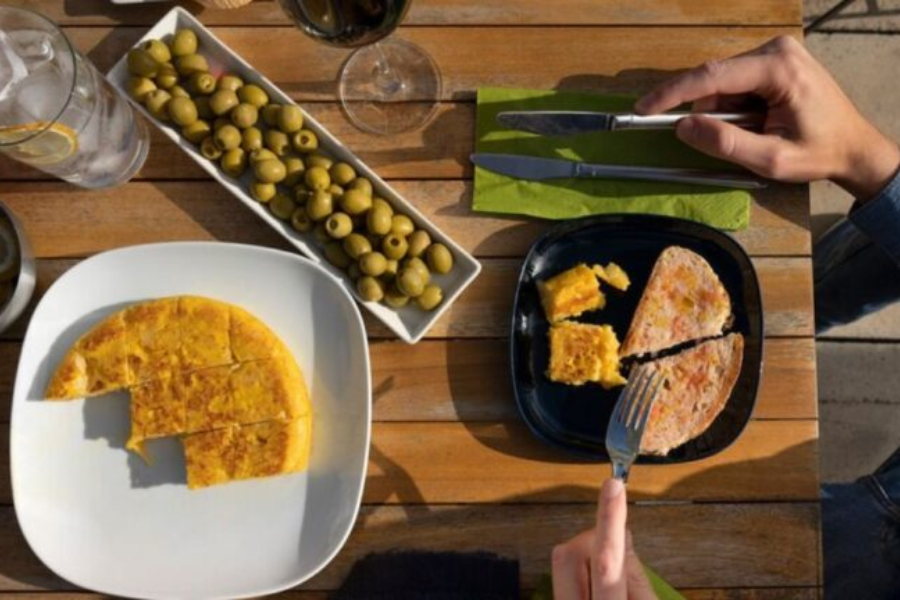A Culinary Journey Through Sicily: The Rich Flavors of Calandrando
Welcome to a culinary adventure where tradition, passion, and history come together in the heart of Sicily. In this post, we explore Calandrando, a dish that reflects the essence of Sicilian gastronomy. Prepare yourself to dive into the vibrant and authentic flavors of Sicily, where every bite is a celebration of this island’s rich culinary heritage.
The History and Influences Behind Sicilian Cuisine
Sicilian cuisine is a mosaic of flavors that tell the story of centuries of trade, conquest, and cultural fusion. From the ancient Greeks and Romans to the Arab, Norman, and Spanish invaders, each civilization that ruled Sicily contributed its own culinary influences to the island. These contributions created a unique gastronomic identity that continues to captivate food lovers worldwide.
One of the most significant influences on Sicilian cuisine came from the Arabs, who introduced ingredients such as saffron, pistachios, almonds, and spices like cinnamon. These ingredients added depth to dishes like arancini (fried rice balls) and cassata (a sweet, ricotta-filled cake). Spanish rule later introduced frying techniques using olive oil, which remains a staple in many traditional Sicilian dishes today.
Over the centuries, these influences helped shape a culinary culture that is truly diverse, combining fresh Mediterranean ingredients with the flavors of the Middle East and beyond. Calandrando is a shining example of this fusion, highlighting how Sicily’s past is brought to life on the plate.
Typical Ingredients and Dishes in Calandrando
Sicilian cuisine is known for its simplicity, using only the freshest local ingredients to create dishes that are both flavorful and satisfying. Calandrando, a traditional Sicilian dish, embodies this approach with its carefully selected ingredients.
At the heart of this dish is tender, slow-cooked beef or veal, simmered to perfection in a rich tomato-based sauce. Fresh herbs such as oregano and basil infuse the dish with the signature aromas of Sicily. The inclusion of vegetables like hearty potatoes and sweet carrots adds both flavor and texture, soaking up the savory juices of the meat to create a delightful harmony of tastes.
The secret to an authentic Calandrando lies not just in the recipe but in the quality and freshness of the ingredients. Sicily’s fertile soil and sunny climate produce some of the best tomatoes, herbs, and vegetables in the world, ensuring that every mouthful of Calandrando is bursting with flavor.
This dish is the epitome of Sicilian comfort food – hearty, flavorful, and deeply satisfying. It’s a reminder of the island’s bountiful produce and the simple yet nourishing meals that have sustained Sicilian families for generations.
Regional Variations and Specialties in Calandrando
Sicily’s varied landscape, from its coastal towns to the inland hills, has resulted in a diverse range of regional specialties, each with its own twist on traditional recipes. Calandrando is no exception, with regional variations reflecting the availability of local ingredients and different cultural influences.
For instance, along Sicily’s coast, seafood plays a major role in the cuisine. Dishes like pesce spada alla ghiotta (swordfish stew) and spaghetti ai ricci di mare (sea urchin pasta) are popular in towns like Trapani and Siracusa. Inland, where the terrain is more suited to livestock and agriculture, you’ll find more meat-based dishes, such as arancini di carne (meat-filled rice balls) and the traditional caponata (a sweet and sour eggplant dish).
Trapani’s cuisine, for example, showcases strong Arabic influences, with dishes like couscous alla trapanese (couscous with fish broth) reflecting the area’s historical ties to North Africa. In contrast, in Catania, you’ll find desserts made with the region’s famous citrus fruits, like cassata and granita.
These regional specialties offer a glimpse into the rich culinary diversity of Sicily, where each town and village has its own unique take on traditional recipes, including Calandrando.
The Role of Food in Sicilian Culture
In Sicily, food is more than just nourishment – it’s a way of life, a cornerstone of the island’s culture and community. Meals are an opportunity for friends and family to come together, share stories, and celebrate life.
Sicilian cuisine is steeped in history, with each dish telling a story of migration, invasion, and survival. From the Greeks to the Arabs, the Normans to the Spanish, each wave of conquerors left their mark on Sicilian food, resulting in a culinary tradition that is as diverse as it is delicious. Calandrando, with its blend of Mediterranean ingredients and age-old cooking techniques, is a perfect example of how food can be a reflection of history.
But food in Sicily is about more than just history – it’s about community. Meals are meant to be shared, and the act of gathering around the table is a cherished tradition in Sicilian households. Whether it’s a family gathering for Sunday lunch or a festive celebration, food brings people together in Sicily.
The deep connection between food and culture is evident in the way traditional recipes are passed down through generations. Grandmothers teach their children and grandchildren how to prepare dishes like Calandrando, ensuring that the flavors of Sicily’s past will continue to be enjoyed for generations to come.
Traditional Cooking Methods and Techniques
One of the defining features of Sicilian cuisine is its emphasis on traditional cooking methods. These techniques, perfected over centuries, are key to creating the rich flavors that Sicilian food is known for.
Slow cooking is a hallmark of Sicilian cuisine. Dishes like Calandrando are simmered for hours, allowing the flavors of the meat, vegetables, and herbs to meld together into a rich, flavorful stew. This method of cooking ensures that the meat is tender and the sauce is infused with layers of flavor.
Another common technique in Sicilian cooking is grilling over open flames, which adds a smoky depth to dishes like grilled fish or vegetables. Frying is also widely used, especially in appetizers like arancini and panelle (chickpea fritters), which are fried until golden and crispy.
The use of fresh, locally sourced ingredients is another cornerstone of Sicilian cooking. From ripe tomatoes to freshly caught seafood, Sicilian cooks take great pride in using the best ingredients available to create dishes that are both simple and delicious.
These traditional cooking methods have been passed down through generations, ensuring that each dish retains the authentic flavors that have made Sicilian cuisine so beloved.
How to Make Traditional Calandrando
Ready to bring the flavors of Sicily into your kitchen? Here’s how to make an authentic Calandrando that will transport you straight to the sun-drenched island.
Start by selecting the freshest ingredients you can find – tender cuts of beef, ripe tomatoes, and fragrant herbs. In a large pot, sauté onions and garlic in olive oil until they become soft and fragrant. Add the meat, searing it on all sides to lock in the flavor.
Next, pour in a rich tomato sauce and let the mixture simmer gently. Add fresh vegetables like carrots, potatoes, and zucchini, allowing them to absorb the savory juices of the meat as they cook. Season with traditional Sicilian spices such as oregano, basil, and a pinch of red pepper flakes for a bit of heat.
Let the dish simmer until the meat is tender and the flavors have melded together. Serve your Calandrando hot, accompanied by a crusty loaf of bread or over a bed of al dente pasta for a truly authentic Sicilian meal.
Where to Experience Calandrando in Sicily
If you want to experience Calandrando at its best, there’s no better place than Sicily itself. Across the island, family-run trattorias and agriturismos (farm stays) serve up homemade versions of this traditional dish, prepared with love and care using recipes passed down through generations.
From Palermo to Catania, you’ll find variations of Calandrando that reflect the local ingredients and culinary traditions of each region. Whether you’re savoring the seafood-rich dishes of the coast or the hearty meat stews of the inland regions, you’re sure to experience the warmth and hospitality that Sicily is famous for.
Modern Twists on Classic Calandrando Recipes
While traditional Calandrando remains a favorite, modern chefs are experimenting with new takes on this classic dish. For a contemporary twist, try using different types of seafood like prawns or clams instead of beef. You can also incorporate exotic spices like saffron or smoked paprika for an exciting flavor profile.
For a vegetarian version, roasted vegetables like eggplant, zucchini, and bell peppers can be used to replace the meat, creating a lighter yet still satisfying dish. Add crispy prosciutto or toasted pine nuts for an extra layer of texture.
Alternatively, try swapping out traditional pasta for zucchini noodles or gluten-free options to cater to different dietary preferences while still enjoying the rich flavors of Calandrando.
Conclusion: Why You Should Experience Calandrando
Exploring Sicily through its cuisine offers a taste of history, culture, and tradition. Calandrando represents the essence of Sicilian cooking, a dish that tells the story of the island’s past while delighting the modern palate.
Whether you’re enjoying it in a rustic trattoria in Palermo or recreating the dish at home, Calandrando is more than just a meal – it’s a connection to Sicily’s rich culinary heritage. So next time you’re craving something hearty, flavorful, and deeply rooted in history, make Calandrando part of your culinary journey.
Stay informed with the news and updates on chagaras




